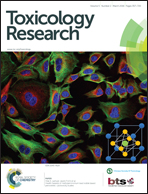Differential expression of serum proteins in rats subchronically exposed to arsenic identified by iTRAQ-based proteomic technology—14-3-3 ζ protein to serve as a potential biomarker†
Abstract
Arsenic is a multi-system toxicant. However, the mechanism of arsenic toxicity is not fully clarified and few effective protein biomarkers could be used for arsenic poisoning. This study was to investigate the differentially expressed proteins in the serum of rats subchronically exposed to arsenic. Sixty male rats were randomly divided into four groups, and the dose of sodium arsenite in drinking water for each group was 0, 2, 10, and 50 mg L−1, respectively. The exposure lasted for 12 weeks. An Isobaric tags for relative and absolute quantitation (iTRAQ)-based proteomic approach was used to identify the differentially expressed proteins in serum between control and 50 mg L−1 groups. A total of 201 serum proteins were identified by iTRAQ, of which 12 were significantly changed by arsenic exposure with two up-regulated and ten down-regulated proteins. One down-regulated protein 14-3-3 ζ, an abundant protein expressed in the brain, was verified by ELISA using serum samples and by immunohistochemical, real time PCR, and western blot methods using brain tissues in four groups. Our work provided valuable insight into the serum protein changes in rats exposed to arsenic, and indicated that 14-3-3 ζ may serve as a useful biomarker for nervous damage caused by arsenic poisoning.


 Please wait while we load your content...
Please wait while we load your content...